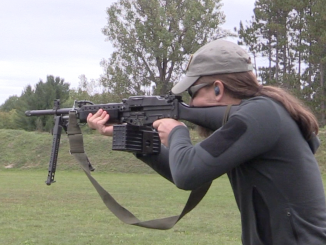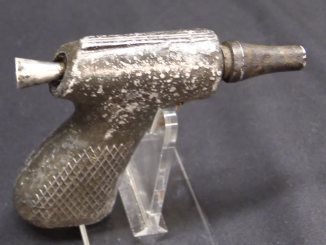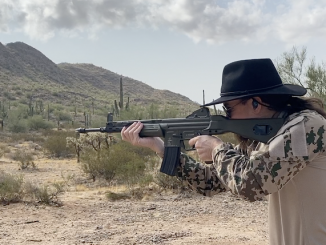The M2 Browning machine gun was first conceived in 1918, as a request by General John Pershing of the AEF for a large-caliber antiaircraft and antitank machine gun. John Browning scaled his M1917 water-cooled .30 caliber design up to .50 caliber, and the first prototypes were test fired in November of 1918. Impetus behind the project faltered after the Armistice, but Colt continued to develop the gun during the 1920s and 1930s. It was first adopted in 1922 by the US Coastal Artillery as an antiaircraft gun, but significant manufacture would not come until World War Two. By this time, the gun’s main role had shifted, from antitank to being an aircraft armament, and some 2 million were made during World War Two, primarily as aircraft guns.
The M2 remains in service today, highlighting the brilliance and longevity of John Browning’s designs. Thanks to Bear Arms in Scottsdale AZ for access to film this M2HB!




I love Ma Duece and her ability to end any argument, saved me many a time overseas in Bosnia and Croatia
“(…)first prototypes were test fired in November of 1918(…)”
Photo of early version of his M2 .50-caliber machine gun can be seen here
https://www.hhshootingsports.com/shop/john-browning-revolutionized-the-firearms-industry/
An AMERICAN company acknowledged and corrected for excess profit? In wartime? My, things have changed.
Thank Senator Harry S Truman’s committee against graft, corruption and waste in war time procurement
“The Truman Committee, formally known as the Senate Special Committee to Investigate the National Defense Program, was a United States Congressional investigative body, headed by Senator Harry S. Truman.[1] The bipartisan special committee was formed in March 1941 to find and correct problems in US war production with waste, inefficiency, and war profiteering. The Truman Committee proved to be one of the most successful investigative efforts ever mounted by the U.S. government: an initial budget of $15,000 was expanded over three years to $360,000 to save an estimated $10–15 billion in military spending and thousands of lives of U.S. servicemen ”
https://en.wikipedia.org/wiki/Truman_Committee
Sat behind one of these for 9 months in 1968/69 on an m113 ACAV. I could change the barrel and set head space and timing in about two minutes on a hot gun. But I have to confess I never ever tore the gun down for a thorough cleaning and was never taught how to. Cleaning meant pouring a can of oil into the breach and charging it several times to excessively oil it up :-). This thing was absolutely iron clad bullet proof and its distinctive rate of fire added to its fear factor for the enemy.
Serious cringe factor in the take-down video…
Ian absolutely needed to do at least one thing, before removing the backplate, and that is to ensure that the bolt is forward, with no tension left on the recoil spring.
You do that casual removal of the backplate with the spring under tension, bolt locked to the rear? You’re in for a rather ugly surprise when/if the recoil spring guide pops out of that itty-bitty little hole the stud is in on the right sideplate. There’s more than enough energy pent up in that thing that it will penetrate both sides of a cinder-block wall in an arms room, and go into the space on the opposite side with considerable vigor. There are safety-of-use reports about that recoil spring having killed people, and I can easily see that being possible.
Never, ever remove that backplate without first checking to ensure that the recoil spring is in its relaxed state. Just trust me on this one.
Kirk,
I certainly trust your judgement when it comes to machine guns!
Ian – I have been waiting for years for this! I was an armourer on P-51 Mustangs (post-war) and spent the majority of my time on this weapon. Wonderful to see the guts of the gun again. We were told that the accelerator ‘lever’ was a ‘claw’ and, as well as slowing the bolt opening, it the sped the bolt up in recoil before the bolt hit the buffer at the rear. I understand that when used in F-86’s it achieved rates of fire close to 1000 rounds per minute. This was done by hoisting the ammunition belts with a motor, thus relieving the gun of the work. Once again thanks.
F-86’s it achieved rates of fire close to 1000 rounds per minute
Faster firing version for usage as aircraft machine gun, called AN/M3 fired 1150-1250 rounds per minute according to
http://www.imfdb.org/wiki/Browning_M3
I recall when one of our company cooks was headed for Nam. He wasn’t happy about it, even though he’d continue slinging hash over there. But when a man who’d done a tour assured him that his kitchen equipment would include what we then called an “M50,” he cheered up, at least a little.
That was in 1967. It’s startling to hear infantry of today saying of the M2, “It’s a giant machine gun. What’s not to love?”
Sure, you could build a better .50 today, probably. But it wouldn’t inspire that solid iron confidence.
I believe the accellerator acts to accellerate the bolt on recoil. As the barrel and barrel extension move to the rear, the accellerator starts moving the bolt to the rear faster, providing primary extraction and slightly slowing the barrel and barrel extension. In 29 years, I never got to fire one except with blanks, had to save all of our limited ball ammunition for the troops who needed to qualify with it.
Wwii the Germans, and the Japanese, but the Germans absolutely scared to death of it!! It would remove an arm or leg or cut them in half!! As fearfull as we of THEIR RAPID FIRE MG42!!
The U.S. procedure of putting a .50 on top of most trucks and etc. on a ring mount, in addition to pedestal mounts on top of AFVs, made strafing an American armored column or truck convoy a decidedly unpleasant experience for Axis fighter pilots.
Whereas a Commonwealth column might have at best a few Brens on AA mounts on certain vehicles, such as the Universal Carrier, an American column could and would greet a ground strafer with a literal firestorm of .50 caliber fire. Such strafing attempts quickly turned into full-on gunfights with the odds heavily favoring the ground forces.
As an old saying goes, “Most infantry problems have a simple solution- one half inch in diameter”.
cheers
eon
Thank Senator Harry S Truman’s committee against graft, corruption and waste in war time procurement
“The Truman Committee, formally known as the Senate Special Committee to Investigate the National Defense Program, was a United States Congressional investigative body, headed by Senator Harry S. Truman.[1] The bipartisan special committee was formed in March 1941 to find and correct problems in US war production with waste, inefficiency, and war profiteering. The Truman Committee proved to be one of the most successful investigative efforts ever mounted by the U.S. government: an initial budget of $15,000 was expanded over three years to $360,000 to save an estimated $10–15 billion in military spending and thousands of lives of U.S. servicemen ”
https://en.wikipedia.org/wiki/Truman_Committee
Senator Truman went to France and got shot at with the Missouri National Guard,in which he had been a pre war enlisted man. He stayed interested in military matters, and remained an active reservist until after the second war. His perspective was always colored by his experience as a fighting soldier and he kept that perspective. Woe betide the profiteer and shoddy contractor in front of his committee.
Senator Truman want to do active military service during WWII, but was turned down as being too old https://en.wikipedia.org/wiki/Harry_S._Truman#Officers'_Reserve_Corps
Let us not forget that Gunny Hathcock took out a VC at log range with a single round from Ma Deuce mounted on a tracked vehicle.
Oorah!
Nice story but none of the fifties in my unit on the AVACs or tanks had single shot capability unless i guess you figured how to purposely load it with a single round.
Au contraire, my friend. Every M2HB in the inventory has the ability to fire single shots. What you lacked were people who knew what the hell they were about, or who would bother to crack a manual to learn for themselves.
Common problem across the US military. Fought it for 25 years, and it is still in ample evidence, even with the people who write the manuals and are supposedly “subject matter experts”.
According to https://modernfirearms.net/en/machineguns/u-s-a-machineguns/browning-m2hb-eng/
The M2HB has an unusual method of providing semi-automatic fire (probably added to the basic design as an afterthought) – it has a bolt latch, which locks the bolt to the bolt buffer in the open position after each shot. Therefore, if the gun is fired in semi-automatic mode (single shots), for each shot the operator must first release the bolt forward by pressing the bolt latch release, located next to the thumb trigger. After the bolt is released and the gun is loaded, the operator may push the trigger to fire a single bullet.
A strange find over here in France at a fleamarket was about 25 recoil springs for this gun
They cost me all of 5 francs and were brand new
I know the french still use this gun but why just the springs
Probably came out of a depot somewhere, or got left behind in an armorer’s chest somehow, and the rest of the parts were of more utility. There’s not much you can do with a recoil spring from an M2HB besides use it as a recoil spring…
Back in the day, I used to haunt the turn-in point where they had a place for units to turn in unwanted or unused parts so they could be used by someone else. You would be astounded at what sometimes shows up at your unit when you make a transposition error on a requisition slip–Dude I knew of at Fort Sill back during the early 1980s screwed something up, and an anchor from one of the Army’s landing barges showed up on a flatbed one afternoon. How the hell that snuck through all the controls in the system, I’ll never know, but it was something that was entirely possible to have happen.
The transportation codes are another thing, entirely–Wartime movements into the Middle East were full of fun little “issues” I spent a lot of time trying to clear up in Kuwait for my unit. If someone fat-fingered the computers, and the wrong bar codes got on something…? LOL. Try four armored D9 bulldozers whose movement tags said they belonged to some Air Force Reserve fighter wing somewhere in the Dakotas, and which had mysteriously shown up on the docks at Ash Shuaibah as the only cargo coming off of an Army RORO transport that normally carries a full brigade’s worth of equipment and material…
Unless I have misread my history, the US Navy did not take air attack on their ships all that seriously (Billy Mitchell notwithstanding) right up until Pearl Harbor. Torpedo boats, however, and shore-raiding parties in small craft, were considered serious threats. This weapon with this ammunition was a fearsome counter to anything small, fast, lightly armored or non-armored (usually made of wood) that depended on coming in close — is still devastating to soft-skin land vehicles. Not bad either for shooting up enemy troops or hostile rioters approaching the dockside or river bank, or covering your raiding parties of Marines attacking onshore and/or returning to ship. For the same purposes the Navy adopted the 1895 Colt-Browning (sounds familiar?) three decades earlier, and the Gatling gun before that.
E -MAIL reply from 3 tour VN HS buddy I sent this to. I can tell you from personal experience that they are absolutely right
about operating the charging handle with out the back plate attached.
Fortunately I was Standing over the gun and not behind it.
I can also attest that under no circumstances should you pull the
trigger on an M3A1 with the bolt cocked and the barrel removed. Although
it was fun to watch.
Do you, or did you already, plan to make a video on the Mark 19 grenade machine gun.
Participated in a Marine Corps Battalion live fire once and, after seeing the devastating results of the Mk 19 in action, wondered why any opposing force would ever face us on the battlefield.
The M2 was the prevalent aircraft arm in the Korean conflict as well. It was used in the F51, Navy Panther, F86, F80, B29 and many others.